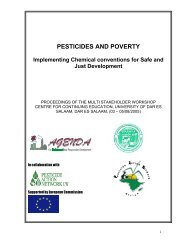Hazardous pesticides and health impacts in Africa - Pesticide Action ...
Hazardous pesticides and health impacts in Africa - Pesticide Action ...
Hazardous pesticides and health impacts in Africa - Pesticide Action ...
Create successful ePaper yourself
Turn your PDF publications into a flip-book with our unique Google optimized e-Paper software.
However, this ignores the hazards aris<strong>in</strong>g from the toxicity of<br />
the compounds used <strong>in</strong> <strong>Africa</strong> <strong>and</strong> serious shortcom<strong>in</strong>gs <strong>in</strong><br />
h<strong>and</strong>l<strong>in</strong>g practices, such as lack of protective equipment.<br />
Another mistaken assumption is that pesticide <strong>health</strong> <strong>and</strong><br />
environmental <strong>impacts</strong> <strong>in</strong> <strong>Africa</strong> are ma<strong>in</strong>ly related to largescale,<br />
commercial or plantation farms, while smallholder<br />
farm<strong>in</strong>g systems for food crops are generally viewed as low<strong>in</strong>put,<br />
with m<strong>in</strong>imal or zero use of <strong>pesticides</strong>. It is true that<br />
<strong>pesticides</strong> tend to be used most <strong>in</strong>tensively on <strong>Africa</strong>n ‘cash’<br />
crops, especially cotton, cocoa, oil palm, coffee <strong>and</strong><br />
vegetables, yet many of these crops are grown<br />
predom<strong>in</strong>antly by smallholders.<br />
Trapped <strong>in</strong> hazardous practice<br />
The research looked at farmers grow<strong>in</strong>g cotton, vegetables,<br />
p<strong>in</strong>eapple, cowpea <strong>and</strong> mixed cereals <strong>and</strong> legumes <strong>in</strong> Ben<strong>in</strong>,<br />
Senegal, Ghana <strong>and</strong> Ethiopia. We found that many farmers<br />
h<strong>and</strong>le, apply, store <strong>and</strong> dispose of <strong>pesticides</strong> <strong>in</strong> ways that<br />
expose themselves, their families <strong>and</strong> sometimes consumers<br />
to serious risks. At least one WHO Class Ia (extremely<br />
hazardous) or 1b (highly hazardous) pesticide or toxic<br />
fumigant was <strong>in</strong> use <strong>in</strong> all the cropp<strong>in</strong>g systems, the<br />
exception be<strong>in</strong>g p<strong>in</strong>eapple <strong>in</strong> Ghana. Class Ia <strong>and</strong> Ib<br />
products were most commonly used on vegetables, <strong>and</strong><br />
farmers often spray up to a few days before harvest, so<br />
putt<strong>in</strong>g consumers at risk. Table 1. lists the n<strong>in</strong>e most<br />
commonly used <strong>pesticides</strong> reported by case study farmers<br />
<strong>and</strong> their acute <strong>and</strong> chronic <strong>health</strong> <strong>and</strong> environmental<br />
hazards.<br />
Most farmers do not use appropriate equipment or protective<br />
measures: <strong>in</strong> Senegal, only 44% of cotton farmers <strong>and</strong> 14%<br />
of vegetable farmers use protective cloth<strong>in</strong>g when spray<strong>in</strong>g<br />
<strong>in</strong>secticides. Common work practices can add to the risk of<br />
us<strong>in</strong>g hazardous compounds: p<strong>in</strong>eapple farmers <strong>in</strong> Ghana<br />
dip plant<strong>in</strong>g material <strong>in</strong> chlorpyrifos solution aga<strong>in</strong>st<br />
mealybug pests yet rarely use gloves. As their h<strong>and</strong>s usually<br />
have open cuts from h<strong>and</strong>l<strong>in</strong>g sp<strong>in</strong>y p<strong>in</strong>eapple foliage,<br />
unprotected dipp<strong>in</strong>g <strong>in</strong>creases the risk of chlorpyrifos be<strong>in</strong>g<br />
absorbed <strong>in</strong>to the sk<strong>in</strong> or bloodstream. When questioned,<br />
farmers expla<strong>in</strong>ed that although they were aware of the<br />
<strong>health</strong> hazards, the ma<strong>in</strong> reason why they don’t use proper<br />
protective equipment is that is expensive <strong>and</strong> often difficult to<br />
f<strong>in</strong>d.<br />
While these wide-rang<strong>in</strong>g symptoms can be caused by many<br />
diseases, farmers highlighted that they were regular <strong>and</strong><br />
predictable effects after spray<strong>in</strong>g. Ghanaian farmers<br />
described a range of symptoms <strong>and</strong> <strong>in</strong>tensity related to us<strong>in</strong>g<br />
different products:<br />
• Endosulfan products raises body temperature, can give<br />
severe headache, stomach ache <strong>and</strong> serious debilitation<br />
(what farmers termed as ‘feel<strong>in</strong>g knocked down’)<br />
• Dursban (chlorpyrifos) exposure has similar effects to<br />
endosulfan without the debilitation but can also br<strong>in</strong>g catarrh<br />
<strong>and</strong> sk<strong>in</strong> rashes;<br />
• Fenom C (profenofos +cypermethr<strong>in</strong>) causes immediate<br />
cough<strong>in</strong>g <strong>and</strong> can produce burn<strong>in</strong>g sensation <strong>and</strong> itch<strong>in</strong>g,<br />
especially on delicate body areas.<br />
Farmers described how exposure dur<strong>in</strong>g spray<strong>in</strong>g made<br />
them so weak <strong>and</strong> sick that they had to stay <strong>in</strong> bed for 2-7<br />
days afterwards to recover. With several applications per<br />
crop, this meant los<strong>in</strong>g between 15-20 days off work per<br />
season for cotton <strong>and</strong> cowpea farmers. Most farmers carried<br />
out some measures to try <strong>and</strong> mitigate some of the<br />
poison<strong>in</strong>g symptoms, ma<strong>in</strong>ly purchase of t<strong>in</strong>ned milk drunk<br />
before or after spray<strong>in</strong>g. For more severe poison<strong>in</strong>g<br />
episodes, they would buy paracetamol, traditional tonics or<br />
pay for sal<strong>in</strong>e drips or other treatment at local cl<strong>in</strong>ics.<br />
Regular sickness related to pesticide exposure thus costs<br />
farm<strong>in</strong>g households considerable sums of money, as well as<br />
time off work <strong>and</strong> lost productivity, estimated at up to US$90<br />
per household (see F&F brief<strong>in</strong>g no.2 on Hidden costs of<br />
pesticide use <strong>in</strong> <strong>Africa</strong>). Farmers viewed regular ill <strong>health</strong><br />
from <strong>pesticides</strong> almost as a fact of farm<strong>in</strong>g life <strong>and</strong> felt<br />
powerless to change their situation. One young mother who<br />
suffered a miscarriage after <strong>in</strong>hal<strong>in</strong>g <strong>pesticides</strong> on the family<br />
cowpea plots, said “The pesticide does its job but it’s the<br />
side effects we don’t like. There is no option-we have to do<br />
this”.<br />
In Ben<strong>in</strong>, 81% of p<strong>in</strong>eapple farmers <strong>and</strong> 43% of vegetable<br />
farmers <strong>in</strong>terviewed reported that the effect of <strong>pesticides</strong> on<br />
their <strong>health</strong> was considerable or noticeable. In Senegal,<br />
24% of cotton farmers <strong>and</strong> 20% of vegetable farmers had<br />
witnessed or heard of cases of pesticide poison<strong>in</strong>g.<br />
Ghanaian p<strong>in</strong>eapple farmers described how spray<strong>in</strong>g<br />
ethephon caused burn<strong>in</strong>g eyes <strong>and</strong> headache, especially if<br />
applied under hot sun. Two workers on a large p<strong>in</strong>eapple<br />
farm had both experienced sk<strong>in</strong> irritation after spray<strong>in</strong>g<br />
<strong>in</strong>secticides, stomach problems after <strong>in</strong>hal<strong>in</strong>g vapours <strong>and</strong><br />
had been hospitalised with pesticide-<strong>in</strong>duced illness for<br />
several days <strong>in</strong> one season. Farmers <strong>in</strong> Ben<strong>in</strong> <strong>and</strong> Ghana<br />
grow<strong>in</strong>g cotton <strong>and</strong> cowpea reported the most regular ill<br />
<strong>health</strong> episodes after spray<strong>in</strong>g <strong>in</strong>secticides, with symptoms<br />
<strong>in</strong>clud<strong>in</strong>g migra<strong>in</strong>e, debilitation, stomach upset, sk<strong>in</strong> <strong>and</strong> eye<br />
irritation, sore throat <strong>and</strong> cough<strong>in</strong>g.
















